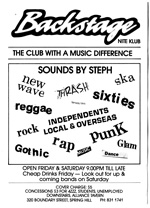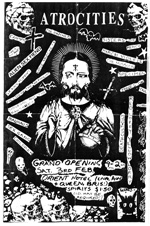This was to have been a rather more insightful introduction to the music of The Jesus Cleaver. Deeply insightful, lyrically explorative, and forward looking. Instead, it has become a rambling walk through recollections, encounters, and misadventures, all centred in and around Brisbane, the “big country town” I grew up in, in the state of Queensland, Australia.
One of my fondest memories of childhood was the time I spent at the Inala Sports Centre’s skate rink. Now derelict, the rink was a thriving centre of youth activity in the 70’s and 80’s. Split Enz’s “I Got You” blasted through the venue’s PA in 1980, and I can recall requesting KISS’s “I Was Made For Lovin’ You” (a number 1 single in Australia in ‘79) at the DJ booth. I went to school in Inala, where visiting one’s best friend to check out their beer can cubby house was something that could be enjoyed in its childhood naivety, rather than being an instant trigger for social services to visit. As it would happen, I grew up just minutes away from Chris Bailey of The Saints, who featured the area in his “Just Like Fire Would” (1987) video (in another Saints-related co-incidence, was later to spend time living just two doors down from “Club 76” in inner-city Petrie Terrace).
Soon I was removed from this particular joy of music and plunged, somewhat prematurely, into an all-boys private school in the city in 1981. I probably spent 4 hours each day commuting via bus, train and foot. Being in the city did have some advantages, in that it was far easier to be exposed to the marketing influence of commercial radio. The teen market was being heavily contested, and “Radio 10” listener cards soon gave way to “FM104” cards (despite Radio 10 getting Boy George to officially open their new studios in July 1984, a truly massive event at the time).
Other avenues also presented themselves, including afternoon television shows such as “Simon Townsend’s Wonder World”, which played music videos such as “Karma Chameleon”. The Australian stalwart, “Countdown”, aired on Sunday nights, and was always an occasion. Songs such as “The Land of Make Believe” by Bucks Fizz and “Heaven (Must Be There)” by Australian act, the Eurogliders, carried through the new wave pop sounds through to the mid 80’s. Prior to the introduction of MTV in Australia, FM104 and BTQ 7 aired “Sevenrock”, which was presented by Bill Reiner and simulcast in FM stereo, at a more “adult” time of 9PM on Friday nights. Videos such as Genesis’s “Land of Confusion” were endured whilst waiting for another replay of Kate Bush spinning herself around in “Babooshka”.
By my early teens, I had come to understand the harsh realities of the cold war – that at the press of a button, I – and most of the population of the world’s cities – could be killed in an instant. Nena’s “99 Luftballons” was much more than a catchy synth bass hook – it was a plea direct from the front line. By the late 1980s, I was still caught in the grip of commercial radio, and had settled on a teenage affair with quirky American band, The Cars, soon collecting all their albums. Whilst I had always appreciated The Cure’s pop hits, I was yet to discover what lay beneath the surface of Mr. Smith’s musical iceberg.
Just as being a teenager began to get serious, I discovered Brisbane’s 4ZzZ FM – the only real alternative broadcaster in town. “Floodland” (1987) was still receiving rotation in 1988, and indie darlings such as REM (“Orange Crush”), Sugar Cubes (“Birthday”), Wolfgang Press, Dinosaur Jr., Depeche Mode et al all expanded my musical horizons at an enormous rate. Suddenly, there was a broad style of music that was actually satisfying to listen too, inspiring, and even the cause of occasional jumping up and down. ZzZ’s 1988 Hot 100 was broadcast on the 1st of January, 1989, and included healthy doses of The Sisters of Mercy (also on rotation at my girlfriend’s house at the time), Joy Division/New Order, Kate Bush, The Jesus and Mary Chain, and The Church.
By high school graduation, I had developed a deep curiosity in the Goth sub-culture. There were occasional features in The Sunday Mail’s social pages which provided some hints, but it wasn’t until early one Friday evening at Central Station when I passed a small group of Goths in full regalia that I was hooked. Then, in 1989, the release of “Disintegration” changed everything. This was a trigger to explore The Cure’s immense back catalogue (including “Faith” and “Pornography”), and I quickly acquired the complete Joy Division back catalogue. Soon, I was introduced to Siouxsie, and my transformation from gawky teenager into brooding adolescent was complete.
Around this time, Brisbane was still largely a cultural police state. In fact, when waiting for friends in the Queen Street Mall, I was asked for ID from the boys in blue, checked against the Persons of Interest database, and then told to “get a haircut” when nothing useful was returned. Suffice to say that the Brisbane of today is completely unrecognisable from the often intense, sometimes violent atmosphere of the day. Andrew Stafford’s “Pig City: from the Saints to Savage Garden” is a must for anyone interested in delving into Brisbane’s cultural depths of despair, and the musical response these pressures generated (including events such as the Livid Festival).
By the time I was old enough to go to clubs, and more critically, had the courage to do so, I had just missed out on attending “Morticia’s” at the Orient. “Backstage”, downstairs at the Alliance, became a regular haunt, and then later, numerous incarnations of clubs at the Normanby. In retrospect, I would have had a much better time if I had spent more money at the bar, rather than saving my pennies for synths and drum machines…
 |
 |
|
| Ancient artefacts, circa 1989 and 1990. | ||
The fact that I can remember these aspects of my life so clearly is a tribute to the power of music. Music has always been something that I have been attracted to – I simply can’t get it out of my head. And even when putting the likes of “Unknown Pleasures” on the shelf for any length of time, the result is always a much greater appreciation of the work upon the next listen. Music has been there at times of elation, and, more often, in times of deep hopelessness and despair. For the longest time (since I began writing as a teenager), I never believed that I could produce a body of work and have anyone else remotely interested in it. Thus The Jesus Cleaver has had a minutely small local following until now. I have come to the realisation that, however small the chance that someone else does take an interest, that interest could be most significant to them, as my musical appreciation is to me.
If you are that person, welcome to The Jesus Cleaver!







Discussion
No comments for “Welcome to The Jesus Cleaver”